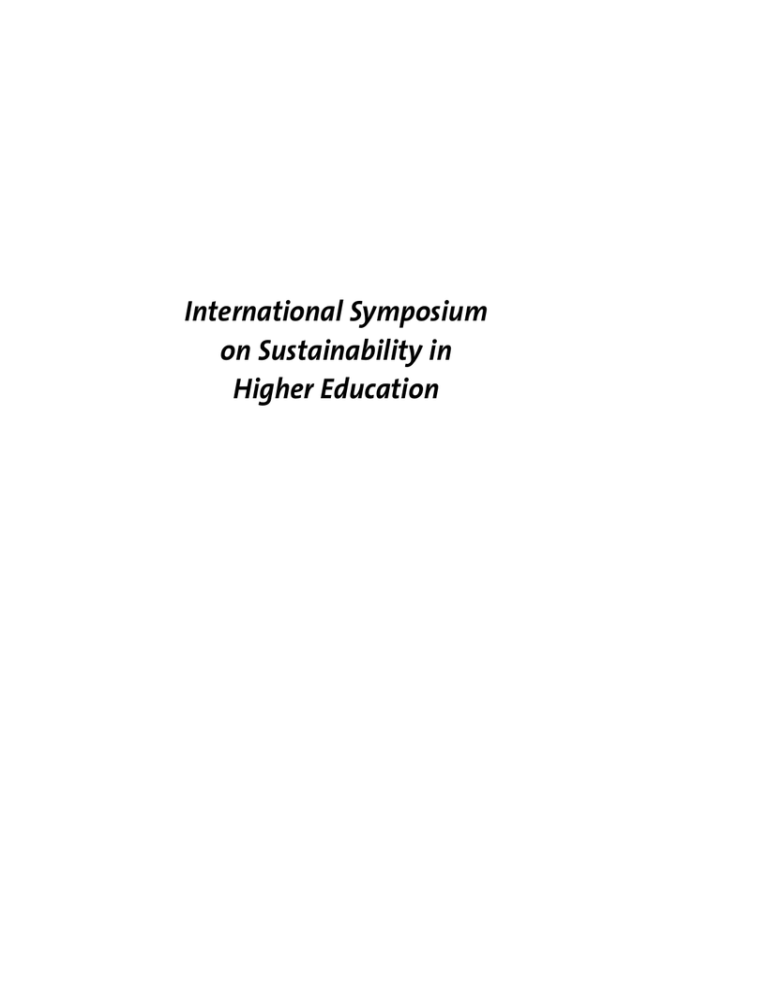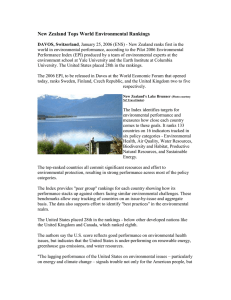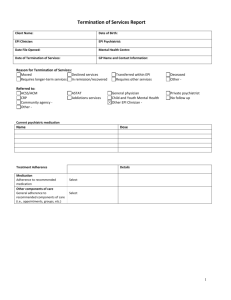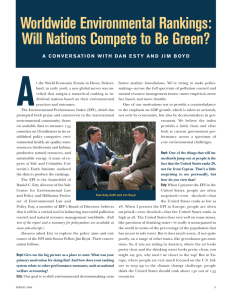International Symposium on Sustainability in Higher Education
advertisement

International Symposium on Sustainability in Higher Education the pilot 2006 environmental performance index The Pilot 2006 Environmental Performance Index and the Role of Higher Education in Advancing Sustainability Around the Globe Summary by Jason Rauch Daniel Esty, Professor of Environmental Law & Policy; Director, Center for Environmental Law & Policy, Yale University Dan Esty has been in the environmental field for 20 years, and can attest to the fact that action on environmental policy comes in waves. The federal government is way behind today, while the business community is doing a good job, and academic institutions are out in front. In the past, environmentalists have been too keen to say no progress has been made, only to be swiped away from importance by politicians claiming no further investment needs be made because no progress has occurred. Newt Gingrich in the Republican take-over of Congress in 1994 utilized this approach. Instead, environmentalists need to refine their statements to say both what is improving, and what is not. An essential ingredient in defining progress is metrics. Metrics provide a clear and concise way to track progress. They are critical to develop and test theories, and provide a medium for teaching others. the role of the university in establishing metrics Universities and individuals need to live what they preach. We cannot be afraid to take risks, and we must be willing to fail and to admit that failure. Advocating solutions to environmental problems should be grounded in sound logic and science. We have to move from emotion and rhetoric to data and facts, and appeal to a greater audience using these data and facts. The environmental index constitutes making the business case for sustainability. yale school of forestry & environmental studies 123 124 strategies for institutionalizing sustainability in higher education Data, metrics, and indicators track whether the money being spent is paying off. A lot of uncertainty exists in the environmental field, which makes these metrics all the more important. For instance, what is a pretty view worth? These difficult questions to answer can be made vivid with real data. The ozone hole and climate change are hard to see, but rigorous science and data have made these problems more selfevident. There is a loss of confidence in expert opinion in the environmental field. Real data can stay this loss of confidence. Competition is a good thing, and has been one factor motivating the development of the Environmental Sustainability Index. Best practices end up being shared, and the losses and mistakes teach lessons to a broader audience. Competition also provides accountability. At Yale, for example, the undergraduate colleges have launched competitions between themselves to reduce energy use. Information age technologies provide huge opportunities to increasing the use and efficacy of metrics. They provide efficient means to collect and manage large sets of data. And not only can environmental harms be tracked effectively, but prices can be ascribed to these harms. the environmental performance index The 2006 Environmental Performance Index (EPI) was put together with these ideas of metrics in mind. The index ranks countries around the world according to environmental performance, which is calculated based upon various underlying metrics. The statistics and calculations used to produce the index have been crosschecked by others, and further critiques are welcome. The EPI is particularly aimed at environment ministers so they can ascertain how well their country is performing relative to their peer group. As such, the EPI brings a business tool into the environmental and government context. The EPI not only provides a ranking system, but also references for governments to identify best practices. The policies utilized by leaders versus laggards can be identified and modified where and when appropriate. In addition, the calculation of the EPI identifies the data gaps in the underlying metrics. For instance, toxic exposure and wetlands protection information did not have enough global coverage for use in a comparative global ranking system. The EPI also provides insights into how good environmental performance is achieved. The indicator of poverty, GDP, has a correlation of .7=r2 with the EPI. Measures of good governance indicate that a better political and media climate also correlates with a higher EPI score. Though the overall rankings provide context, they only exist in aggregate as a starting point. It is more important to focus on the peer group of the country under scrutiny (see Figure 1). It is not fair to compare Haiti or the Dominican Republic with Sweden, but rather Haiti and the Dominican Republic with each other, and Sweden with Norway or Finland. yale school of forestry & environmental studies the pilot 2006 environmental performance index Figure 1 Cluster Analysis Map A sensitivity analysis was performed on the underlying assumptions to see what really matters in the final rankings in the index. Such an analysis provides a means to achieve accuracy of the index. It was found that the assumption that really mattered was the categorization and difference between the human and environmental dimensions. However, the separation between these two dimensions is the very area that has the highest consensus among those engaged in governance. It is good to reveal the assumptions of the analysis, because critiques are valuable and improve the model. The take-away results of the EPI include the fact that every country has something to improve. No country performs the best in every category that is aggregated together in the index. And countries do compare themselves to their peer group. Similarly, for universities, they should identify themselves with their peer group. The EPI also indicates that it is not just wealth that dictates good environmental performance, but also good governance. Figure 2 Implications for universities Metrics and benchmarking are useful decisionmaking tools. Data monitoring and reporting helps focus attention. Indicators should track core university issues. Peer groups (universities of the same size, similar location, etc.) provide context and benchmarking. Multi-stakeholder involvement (faculty, students, staff, administration, community) builds “buy in.” yale school of forestry & environmental studies 125 126 strategies for institutionalizing sustainability in higher education The EPI would do much better with better data. Dan Esty stated that it is “frankly shocking” what is not tracked. With better data, and with better and multiple methods of analyzing the data, the underlying truth can be achieved. Multiple perspectives provide this triangulation. And multiple perspectives sharpen one’s own work while also getting a wider buy-in of stakeholders. discussion Q: What happened to Norway to drop it from a high ranking in the Environmental Sustainability Index (ESI) to the lower ranking in the Environmental Performance Index? A: The ESI is a long-term perspective, while the EPI is a different analysis that focuses upon short-term performance. Q: The reduction of environmental performance to a one number rank may be a double edged sword. It may have the benefits you outlined, but won’t it reduce investment in poor performing countries, which are countries that may need the investment the most? A: The EPI is not making up data. The index is only aggregating data, by adding it up, and publishing it in a new form. For instance, Belgium ranked very low relative to its peer group, and Belgium was shocked. It was a big deal to the environmental ministry. It created a dialogue, which is the intent of the EPI. It forces a conversation that can lead to better performance. And as for a deterrent to investment, it is a good thing, because the world cannot be invested in areas that have poor environmental performance. Q: Why a single number? A: We chose a single number because otherwise people do not pay attention. Once they do pay attention, they can then look at the underlying data to understand the details. Q: In Britain, there is a best practices competition for environmental performance in which the winners receive a prestigious national award. It has been a huge success in motivating action. A: I agree. I am a believer in prizes and awards, as it helps induce a good competitive spirit. Q: Why did you choose child mortality instead of child morbidity? A: Child mortality is actually the single best metric we have for the index because the data are universal. Child morbidity data are not ubiquitous. And child mortality is one of the best signals of core issues centered on environmental health. yale school of forestry & environmental studies







